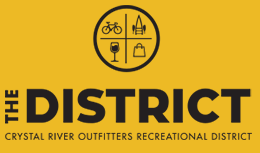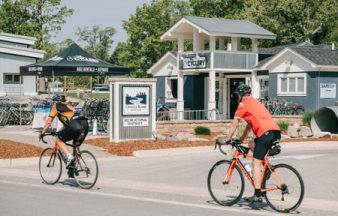Preparing Your Bicycle for Safe Travels

We looked to our Cyclery Service Technician, Karl Kitchen, for information on how to inspect your bike for safety. Here is what he had to say:
Okay, so it’s been a bit of time since your bike has been outside. Maybe it’s been sitting all winter or you just haven’t been riding for some time. It’s a good idea to check a few quick things to make sure your bicycle is in good shape and safe to ride.
Here are a few simple things to check after you brush off the dust:
Tire Pressure
- Make sure your tires are pumped up to the proper pressure and are in good shape. The air pressure recommended for your tires is marked on the tire’s sidewall. It’s usually considered a good idea to pump the tires up to just short of the maximum recommended pressure for a smooth, comfortable ride. As you pump them up, make sure the tread or sidewalls don’t have any excessive wear, cracks, tears, or missing chunks of rubber. If you find any of these, it’s a good idea to simply replace the tire.
Wheels
- If your bike has bolt-on wheels (as is usually the case with kids’ bike especially), make sure the hardware is tight and the wheel is in place securely.
- For bikes with quick-release levers on the wheels, stand the bike on its wheels and open and close the levers. Do the levers work smoothly? Did the wheels “settle into” the frame dropouts when you opened the levers or were they in their proper place? When you closed the levers, did they close against the frame snugly? Lift the wheel off the ground and spin it after you close the lever. Is the wheel spinning smoothly without rubbing the brakes or the bike frame? If so, you’re good here. While you’re at this, grasp the top of the wheel and try to move it back and forth sideways. If the wheel is secure in the frame but the wheels still have sideways play, you might have a problem in your hub that needs looking into.
Hand Brakes
- If your bike has hand brakes, squeeze and release the brake levers a few times.
- Are the levers work smoothly and easily?
- Do the brakes at the wheels open and close smoothly?
- Both sides of the brakes should move evenly. Did they? If the answer is yes, you’re in good shape. You might have an issue that needs a little attention if they do not.
- Check the cables and housings as well. They should be relatively clean with no excessive corrosion or damaged housings.
Chains
- Look at the chain and the gears on the rear wheel.
- Is the chain clean and properly lubricated?
- Are the gears on the rear wheel relatively clean with no bent or missing teeth?
- Does everything move smoothly and quietly when you spin the pedals backward?
Gear Shifts
- For bikes with gear shifts
-
- Do they work smoothly in both directions?
- Take the bike for a short spin in the driveway and shift a few gears up and down. Shifts should be smooth and crisp with little hesitation or excess noise. The cables and housings should be in good shape with no corrosion, cuts, or splits.There are a number of things to check if things aren’t quite working right here. If you have any questions about bad shifts or if you’re not sure of the condition of the chain, then it’s a good idea to get your bike checked out by a professional.
Bearings
- Grab your front brake (if your bike doesn’t have a front brake, turn the front wheel sideways) and rock the bike forward and back lightly.
- Is it nice and firm or do you feel a “tick-tick-tick” in the handlebars when you move it? When handlebars turn smoothly, you’re in good shape. If you feel the “tick”, your headset – the bearings the fork and front wheel turn on – could use some attention.
Pedals
- Grasp one of the pedals and try to rock it back and forth sideways.
- If it’s nice and solid and the crank turns smoothly, life is good. If you feel play, then the bottom bracket – the bearings the crank turns on in the frame – might need a little help.
Seat
- Grasp the front and back of your seat and try to turn it or rock it up and down.
- There should be no movement and the seat should be nice and solid. If it moves, then the hardware should be tightened up.
The Cyclery at Crystal River Outfitter Recreational District provides bicycle tune-ups. All of the items above are part of our inspection procedures when our mechanics inspect your bike for a tune-up. Some problems can be solved with a simple adjustment or two while some issues might take a little bit more work (and, sometimes, new parts) to solve. In either case, we can get you back on the road safely so you can get back to enjoying the ride.
Questions? Stop by The Cyclery and introduce yourself to our technical staff. We’re always happy to answer any questions you might have.
 Good luck and happy trails!
Good luck and happy trails!






